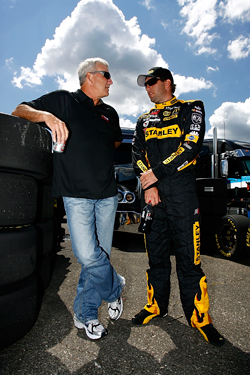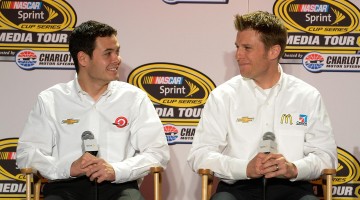 Me: If you had to pick one rule or change that NASCAR made during your career which one had the biggest impact on your career and on you as a driver?
Me: If you had to pick one rule or change that NASCAR made during your career which one had the biggest impact on your career and on you as a driver?
Jarrett: I think probably the biggest thing that came along as far as a change was whenever they required everyone to wear the HANS device. I look at that as a very positive impact and unfortunately this positive impact came from some negative things that happened. We lost a couple of lives to get to that point, to be able to make that decision and make that happen. To me that’s the best thing that has been done in our sport.
There’s a lot of things that have been changed, a lot of rules, some that would be up for argument whether they were better for the sport or just things that were done from what they felt like was necessity to make changes. The racing back to the caution thing where people could get laps back, that was getting a little bit out of hand and something needed to be done. People will argue they don’t like the idea, that now that it’s changed, that someone gets a free pass to get a lap back but it seems to have all worked out better for the sport.
The safety innovations that have come along inside the racecars were tremendous. The newer tracks, and things, have all been very positive for the sport. So there’s been a lot of things that I’ve seen, but I certainly think that the HANS device has been the biggest and one improvement that we had to have for the safety of our drivers in the sport.
Me: With Silly Season going on for what seems like all year long these days, do you think drivers get enough time to really prove themselves when they come to a team? Some guys have been there for a year, maybe two years, and then they’re getting swapped out again. Does the need for sponsors and money make it harder to get results and for a driver to prove themselves?
Jarrett: This kind of goes back to what we were discussing a little bit earlier about how young the drivers are in coming along now, that’s the positive side as they get those opportunities at a very young age. The other side of it is that as they get those opportunities to make their mark in the sport at a very early age, if things don’t go exactly as planned for them then they can also find that exit to the sport a lot sooner.
There’s not as much tolerance this day in time, you’re expected to produce. When you’re given these opportunities at a young age you’re expected to produce quickly. If that doesn’t happen then you can find yourself on the outside looking in and I would say that that can be very devastating to a lot of young people at that time of their life. So again, they have these opportunities early but there’s not as much patience given to these young drivers.
The teams, there’s so much pressure out there to keep sponsors around and to have these major sponsors that everyone wants to be producing and you’re not giving these drivers as much time to do that. It’s a situation that is very difficult. I don’t know that there’s an answer, it’s just if you’re going to take the chance of going in there and getting that opportunity at that young of an age you have to also be willing to accept the responsibility that if things don’t go well then you may be fighting for your job much quicker.
Is it fair? Gosh, that’d be hard to say. I don’t know if we’re given anything and told that anything about it was going to be fair. So you have to know that going in and I think that’s why as young drivers come into this they really, really have to look and focus on decisions that they’re making for their future at a very early age in life and make sure that they’re putting themselves in the right situation because just one wrong move could mean that you’re never going to get that first-class opportunity that you want.


